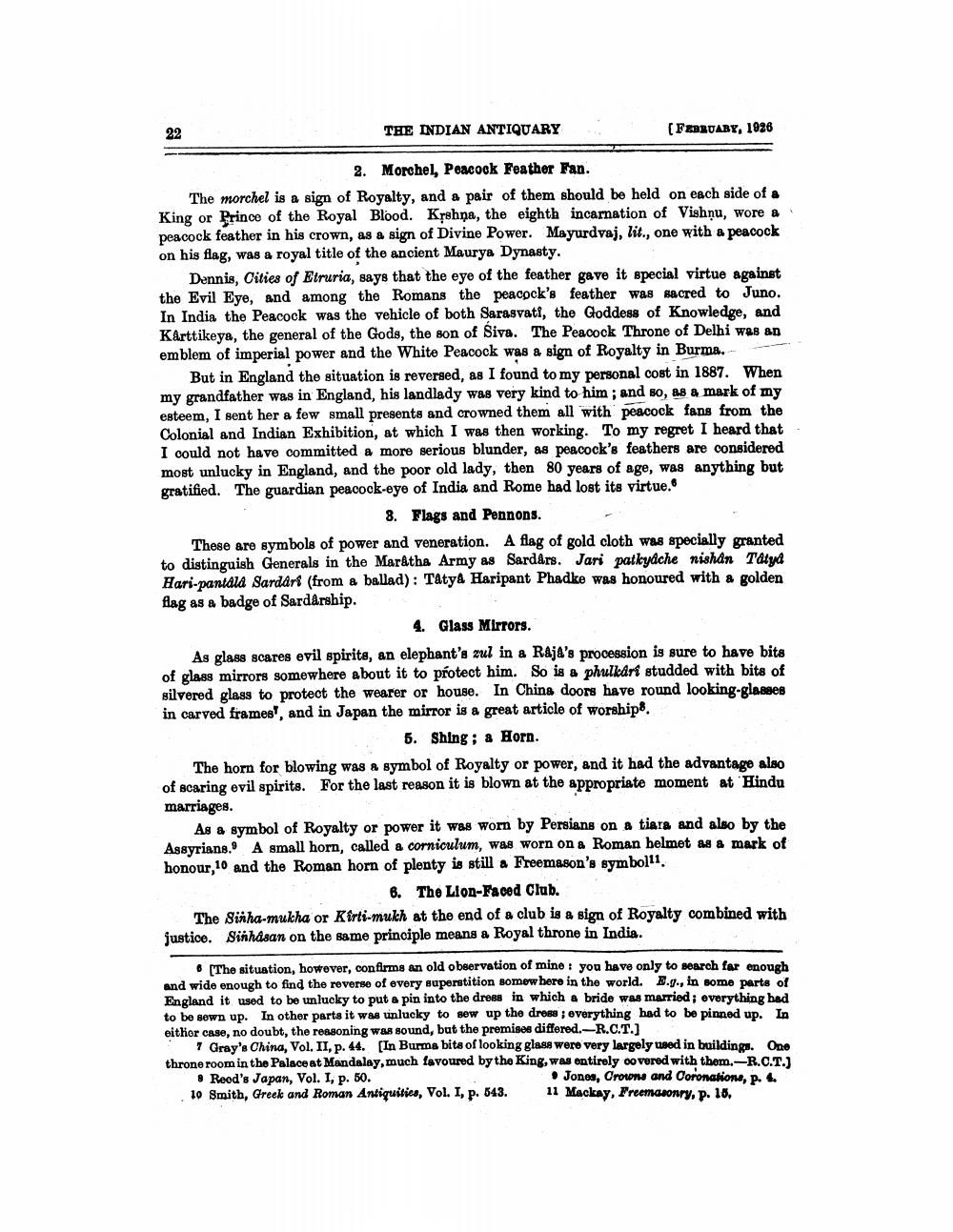________________
22
THE INDIAN ANTIQUARY
[FEBRUARY, 1926
2.
Morchel, Peacock Feather Fan.
The morchel is a sign of Royalty, and a pair of them should be held on each side of a King or Prince of the Royal Blood. Krshna, the eighth incarnation of Vishnu, wore a peacock feather in his crown, as a sign of Divine Power. Mayurdvaj, lit., one with a peacock on his flag, was a royal title of the ancient Maurya Dynasty.
Dennis, Cities of Etruria, says that the eye of the feather gave it special virtue against the Evil Eye, and among the Romans the peacock's feather was sacred to Juno. In India the Peacock was the vehicle of both Sarasvati, the Goddess of Knowledge, and Karttikeya, the general of the Gods, the son of Siva. The Peacock Throne of Delhi was an emblem of imperial power and the White Peacock was a sign of Royalty in Burma.
But in England the situation is reversed, as I found to my personal cost in 1887. When my grandfather was in England, his landlady was very kind to him; and so, as a mark of my esteem, I sent her a few small presents and crowned them all with peacock fans from the Colonial and Indian Exhibition, at which I was then working. To my regret I heard that I could not have committed a more serious blunder, as peacock's feathers are considered most unlucky in England, and the poor old lady, then 80 years of age, was anything but gratified. The guardian peacock-eye of India and Rome had lost its virtue.
8. Flags and Pennons.
These are symbols of power and veneration. A flag of gold cloth was specially granted to distinguish Generals in the Maratha Army as Sardars. Jari patkyâche nishân Tâtyá Hari-pantala Sardars (from a ballad): Tatya Haripant Phadke was honoured with a golden flag as a badge of Sardarship.
4. Glass Mirrors.
As glass scares evil spirits, an elephant's zul in a Raja's procession is sure to have bits of glass mirrors somewhere about it to protect him. So is a phulkart studded with bits of silvered glass to protect the wearer or house. In China doors have round looking-glasses in carved frames, and in Japan the mirror is a great article of worships.
5. Shing; a Horn.
The horn for blowing was a symbol of Royalty or power, and it had the advantage also of scaring evil spirits. For the last reason it is blown at the appropriate moment at Hindu marriages.
As a symbol of Royalty or power it was worn by Persians on a tiara and also by the Assyrians. A small horn, called a corniculum, was worn on a Roman helmet as a mark of honour, 10 and the Roman horn of plenty is still a Freemason's symbol11.
6. The Lion-Faced Club.
The Sinha-mukha or Kirti-mukh at the end of a club is a sign of Royalty combined with justice. Sinhasan on the same principle means a Royal throne in India.
[The situation, however, confirms an old observation of mine: you have only to search far enough and wide enough to find the reverse of every superstition somewhere in the world. E.g., in some parts of England it used to be unlucky to put a pin into the dress in which a bride was married; everything had to be sewn up. In other parts it was unlucky to sew up the dress; everything had to be pinned up. In either case, no doubt, the reasoning was sound, but the premises differed.-R.C.T.]
7 Gray's China, Vol. II, p. 44. [In Burma bits of looking glass were very largely used in buildings. One throne room in the Palace at Mandalay, much favoured by the King, was entirely covered with them.-R.C.T.] 8 Reed's Japan, Vol. I, p. 50. ⚫ Jones, Crowns and Coronations, p. 4. 11 Mackay, Freemasonry, p. 18,
10 Smith, Greek and Roman Antiquities, Vol. I, p. 543.




